
My best look
Lynda has 4 beehives filled with colonies that she caught as swarms, and they are all insanely productive. There are always hundreds of bees flying around near the hives and dancing in the flower patches. She hadn’t looked inside them for about a month so we decided it was time to check in on their current situation.
Upon opening the first hive we immediately saw that we needed to place another box on top because it was jam-packed in there! Bees were running over each other in masses and they built large lumps of protruding honeycomb from the frames to try to expand their home. These bulges can make beekeeping more challenging, as I experienced firsthand. The frames were really hard to pull out of the box since they were all practically meshed together with so much honeycomb. We used the hive tool to break them all off, otherwise in the future it will grow even worse and be more difficult to check on the bees health. As we went through the frames we saw lots of capped honey, and tons of both worker and drone brood, basically every cell was filled. The coolest thing I saw was some very freshly laid brood, when the frame was held up to the sun I could see little eggs like baby grains of rice which meant that the brood wasn’t very old at all. When checking on a hive, it’s good to find the queen because you want to know if she is still there, but seeing this is just as good of a sign because when we saw it we knew that she was here recently and still doing her job.
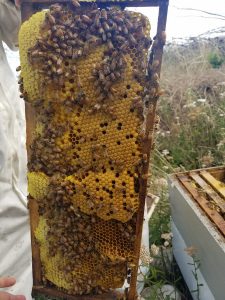
Honey around the left edges, brood in the middle right section
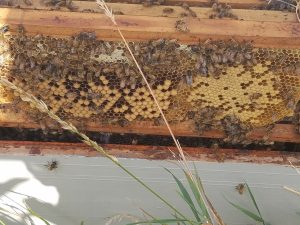
A good frame for showing the difference between drone and worker brood. The drone brood is on the left and is a slightly darker color with a more rounded bulb coming out of the comb rather than the more flat appearance of the workers
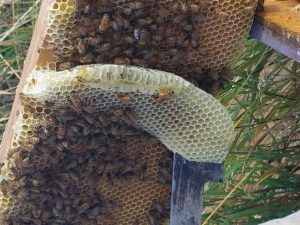
-
Huge chunk of comb sticking out
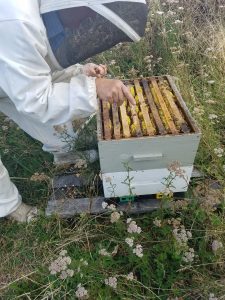
These frames were so hard to wiggle out of the box!
After removing all of the big sections of comb extending outwards, we scraped the edges of the hive for propolis, which is a resin-like substance produced from pollen that bees use to seal the edges in the hive. Propolis is a wonderful anti-bacterial and anti-inflammatory agent that can be a powerful medicine against wounds when made into a tincture, so we harvested as much of it as we could scrape. Once this was done we closed the hive again because we could tell that life was flourishing here, and the bees were starting to get more anxious and aggressive, I did get stung a few times because I didn’t have gloves (but it was well worth the experience)!
There were 4 of us doing the beekeeping so since there were still 3 hives left after we watched Lynda do the first one, we each got to practice doing our own. All of the other hives were equally, if not more prolific so we needed to put a new box on top of each of the 4 hives.
Lynda had a bunch of excess frames and boxes from a friend who gave up beekeeping after the death of a few colonies. They were really full of molding wax and stuff so we had to use the hive tool to scrub all of it off before we could put the boxes on, and we changed the wires on them too.
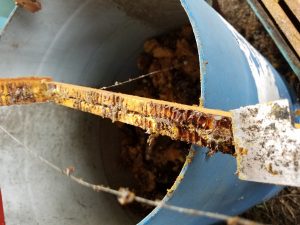
Now that all of the bees have new editions to their homes I’m sure they’re ecstatic and working hard to fill it up! Hopefully it will be a great year for honey yields.






